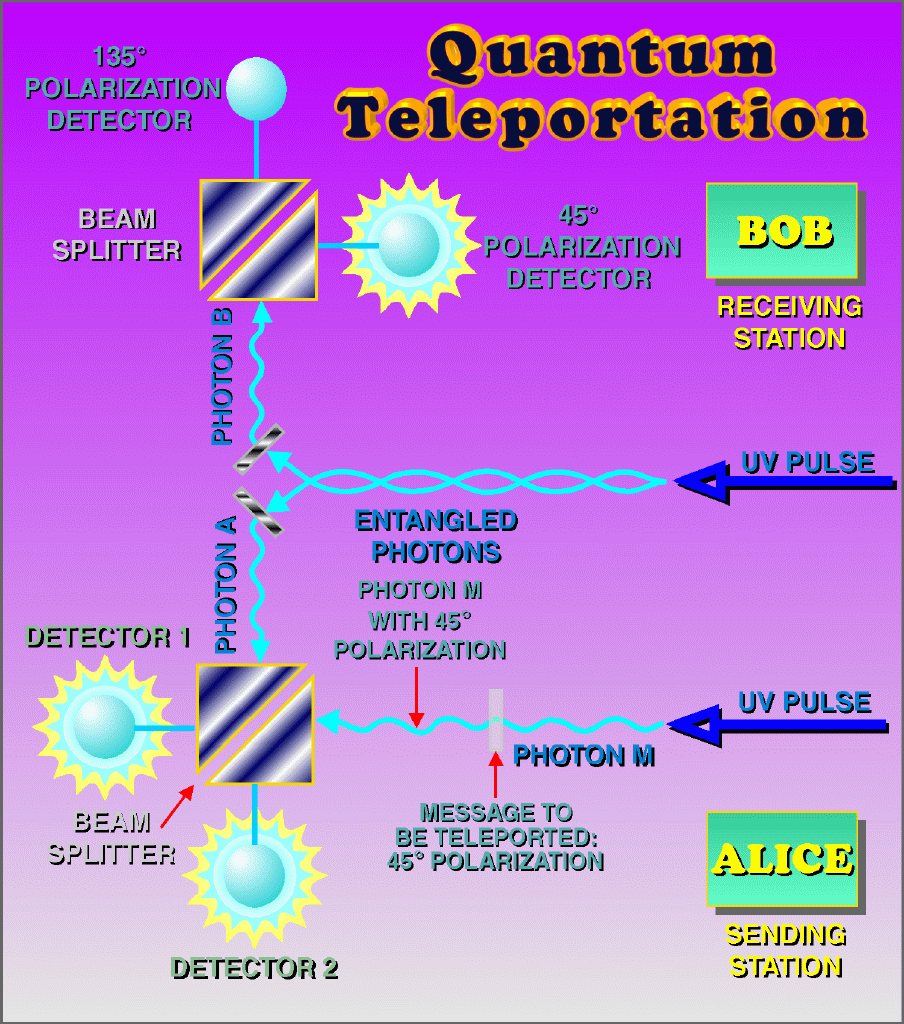

Teleportation
Travel Without Moving
Quantum Teleportation
(Nature.com)
Teleportation of a quantum state uses the phenomenon of quantum entanglement as a means of transmission. When two or more particles are entangled, their quantum states are interdependent, no matter how far apart they are.
A BBC headline, ‘First object teleported to Earth’s orbit’, has to be one of the most fantastical you’ll see this year. For once, it seems the future that science fiction promised has arrived! Or has it?
The article was talking about reports by Chinese scientists that they had transmitted the quantum state of a photon on Earth to another photon on a satellite in low Earth orbit, some 1,400 kilometres away1. That kind of transmission — first demonstrated in a laboratory 20 years ago - is known as quantum teleportation.
It’s a label that can mislead the unwary, as the BBC headline demonstrates. A write-up of the work in Discover reports that the scientists “have successfully transmitted quantum entangled particles” — only to clarify, confusingly, that “unlike science fiction teleportation devices, nothing physical is being transported”.
Physicist Rolf Landauer3 said information is physical. So if you send nothing physical, how can you transmit anything at all from A to B?
The procedure begins by entangling a pair of particles to set up the quantum transmission channel. Photon particle A is held by the sender — call her Alice — and B is sent to the receiver, Bob. Because the particles are entangled and thus interdependent, if Alice performs a physical operation on hers, that can be instantaneously reflected in the state of Bob’s. Alice also has another particle M: one whose quantum state she does not know, but wants to teleport onto B.
To perform the teleportation, Alice makes a special kind of measurement, called a Bell measurement, on particles A and M together. Crucially, this doesn’t tell her what state M is in. But because of the entanglement between A and B, it places B in a state that can be turned into whatever state M originally had, if Bob applies the right operation. By making her measurement, however, Alice has erased that state from M itself.
“Teleporting an unknown quantum state via dual classical and Einstein-Podolsky-Rosen channels.”
This discovery, that you can move information about one state to another location, was made in 1993 by the team of Charles H. Bennett, Gilles Brassard, Claude Crépeau, Richard Jozsa, Asher Peres and William K. Wootters in their paper,

Human Teleportation
BY KEVIN BONSOR & ROBERT LAMB
Seth Brundle, Jeff Goldblum’s character in “The Fly” reminds us just how messy the whole teleportation business can be.
Sadly, the transporters of "Star Trek" and the telepods of "The Fly" are not only a far-future possibility, but also perhaps a physical impossibility. After all, a transporter that enables a person to travel instantaneously to another location might also require that person's information to travel at the speed of light -- and that's a big no-no according to Einstein's theory of special relativity. Also, for a person to teleport, the teleporter's computer would have to pinpoint and analyze all of the 10^28atoms that make up the human body. That's more than a trillion trillion atoms. This wonder machine would then have to send the information to another location, where another amazing machine would reconstruct the person's body with exact precision.
How much room for error would there be? Forget your fears of splicing DNA with a housefly, because if your molecules reconstituted even a millimeter out of place, you'd "arrive" at your destination with severe neurological or physiological damage. And the definition of "arrive" would certainly be a point of contention. The transported individual wouldn't actually "arrive" anywhere. The whole process would work far more like a fax machine -- a duplicate of the person would emerge at the receiving end, but what would happen to the original? What do YOU do with your originals after each fax?
It stands to reason, then, that every successful bio-digital teleportation would be an act of murder and creation. Each use would see the digitalization of your body's every detail, the creation of a genetic clone complete with all the travelers' memories, emotions, hopes and dreams.
The original copy would have to die; that is, unless we're cool with the notion of duplicating ourselves every time we need to travel cross-country and committing infanticide each time little Jimmy heads to school. As with all technologies, scientists will surely continue to improve upon the underlying concepts of teleportation. One day, such a harsh vision of life, death and teleportation may well seem barbaric and uninformed. Our ancestors may feel their bodies fade and dematerialize on one world, even as their eyes open on a planet untold light-years away.
Author's Note: How Teleportation Will Work
Teleportation is one of those "Frankenstein" technologies that terrify us even as they inspire us. Surely, the power to travel instantaneously from New York to Bangkok or from Earth to Alpha Centauri is certainly a power worth grasping after. It could ultimately guarantee the survival of the human race and its peripheral technologies could change fundamentally what it is to be human.
After all, if a machine can digitize everything that's you and rebuild it on the other side of the planet, then why bother with a perfect copy? How about an enhanced copy that's younger, smarter, stronger and happier? Why should you ever worry with getting old when you can simply pass through the teleporter and emerge renewed?
Bio-digital teleportation tempts and haunts us. It's why so many of our sci-fi visions of it involve inherent tragedy and dehumanizing horror. Because if we ever achieve it, we'll have mastered life, death, matter, space and time. Surely, some barrier should stand between humanity and such godhood, right? –- Robert Lamb


